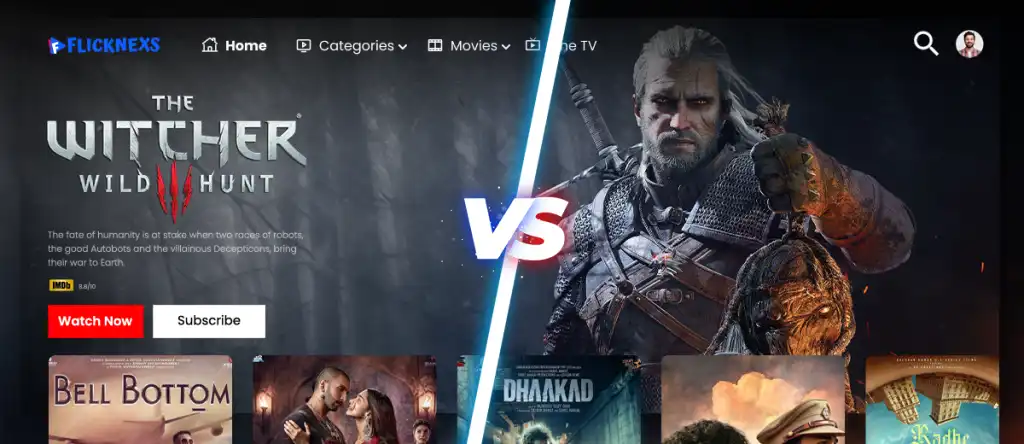VOD vs OTT are both revolutionizing the way we consume content. Video on demand allows users to access and watch videos whenever they want, giving them the freedom to choose from a library of pre-recorded content. It’s like having a personal video library at your fingertips.
On the other hand, OTT refers to the delivery of video content over the internet, bypassing traditional cable or satellite providers. OTT platforms like Netflix and Hulu, offer a diverse range of content, including live streaming and on-demand options. Unlike VOD, OTT is not limited to a specific device or location, providing a more flexible viewing experience. In essence, VOD focuses on individualized content access, while OTT encompasses a broader spectrum of content delivery methods, reshaping the landscape of entertainment consumption
What is VOD?
Video On Demand allows users to access and watch video content at their convenience. It enables viewers to select and stream movies, TV shows, or other videos directly to their devices, such as smartphones, tablets, or smart TVs, over the internet. VOD eliminates the need for traditional broadcast schedules, providing users with the freedom to watch content anytime, anywhere. Not including that, on demand contents can be streamed over the internet, cables as well. With VOD, viewers have control over what they watch, pausing, rewinding, or fast-forwarding as desired. Popular VOD platforms include Netflix, Amazon Prime Video, Hulu, and Disney+, offering a wide range of content for on-demand viewing pleasure.
How Does VOD Work?
Content Delivery: VOD works by storing video content on servers or cloud-based platforms.
User Request: When a user wants to watch a specific video, they send a request to the VOD service provider through a connected device, such as a smart TV, computer, or mobile device.
Video Streaming: The VOD server retrieves the requested video from its storage and initiates the streaming process.
Adaptive Streaming: VOD systems often employ adaptive streaming techniques to optimise video quality based on the user’s internet connection.
On-Demand Playback: It enables users to have full control over their viewing experience.
Digital Rights Management: The services employ DRM mechanisms to protect the copyrighted content from unauthorised distribution. DRM ensures that only authenticated users with proper rights can access and view the video content.
What is OTT Streaming?
OTT streaming refers to the delivery of video content over the internet directly to viewers, bypassing traditional broadcast or cable television platforms. It allows users to access and stream a wide range of on-demand movies, TV shows, and other media content anytime, anywhere, using various internet-connected devices such as smartphones, tablets, smart TVs, and streaming devices. OTT streaming services, such as Netflix, Amazon Prime Video, and Disney+, offer subscription-based models that provide users with a vast library of content to choose from, often without the need for a cable or satellite TV subscription. It has revolutionized the way we consume entertainment by providing flexibility, convenience, and personalized viewing experiences.
How Does OTT Work?
Content Providers: OTT platforms are typically operated by content providers who acquire or produce various forms of digital content.
Streaming Technology: It relies on streaming technology to deliver content directly to viewers devices over the internet.
Internet Connectivity: OTT requires a stable internet connection for users to stream content seamlessly.
Subscription or Ad-supported Models: The platforms generally operate on either a subscription-based or ad-supported model. Subscription-based services require users to pay a monthly or annual fee to access content, while ad-supported platforms offer content for free but display advertisements during playback.
On-Demand Access: OTT enables on-demand access to content, allowing viewers to choose what they want to watch and when they want to watch it.
Personalization and Recommendation: OTT platforms often employ algorithms and data analytics to personalise the content recommendations for users. By analysing users’ viewing habits, preferences, and ratings, these platforms can suggest relevant content based on individual tastes, enhancing the user experience.
Short video of VOD vs OTT
Advantages Of VOD
- Access content anytime, anywhere with Video on Demand.
- Wide selection of movies and shows to choose from.
- Pause, rewind, and fast-forward through your favourite programs.
- Pay for what you watch without additional fees.
- Tailor your viewing experience to your preferences.
- Enjoy immediate access to desired content.
- Available on multiple devices and platforms.
Advantages Of OTT
- Vast selection of movies, TV shows, and documentaries.
- Tailored recommendations based on individual viewing preferences.
- Choose what to watch and when to watch it.
- Exclusive shows and movies not available elsewhere.
- Access content anytime, anywhere with internet connection.
- Stream on smartphones, tablets, smart TVs, and more.
- Download content to watch offline without internet connection.
- Available worldwide, breaking geographical boundaries.
Difference Between VOD vs OTT
| Criteria | VOD (Video on Demand) | OTT (Over-the-Top) |
| Content Delivery | Offers on-demand access to a specific library of content | Provides a wide range of media content streamed over the internet |
| Service Examples | iTunes, Google Play Movies & TV, Vudu, and cable/satellite TV on-demand services like Comcast Xfinity On Demand. | Netflix, Amazon Prime Video, Hulu, Disney+, and HBO Max. |
| Business Model | Subscription-based or pay-per-view | Subscription-based with or without ad-support. |
| Platform | Typically accessed through smart TVs, computers, smartphones, and streaming devices | Available on various devices like smart TVs, streaming devices, gaming consoles, smartphones, and tablets |
| Content Availability | Generally includes a fixed library of content, with new releases added periodically | Offers a mix of live and on-demand content, with new episodes or events often streamed in real-time |
| Content Customization | Users have control over when and what content they watch | Content recommendations and personalised experiences are common |
| Advertisements | May be ad-free or include limited advertisements | May include advertisements, especially on ad-supported platforms |
| Cost Structure | Subscription fees or pay-per-view charges | Subscription fees, sometimes with additional costs for premium content or ad-free experiences |
How Flicknexs Helps in VOD vs OTT

Flicknexs leverages both Video on Demand and Over the Top platforms to offer diverse content delivery. VOD allows users to access and stream content on-demand, providing flexibility in viewing choices. On the other hand, OTT extends the reach beyond traditional broadcast, delivering content over the internet without the need for cable or satellite subscriptions. Flicknexs seamlessly integrates these technologies, ensuring a user-friendly experience with a vast array of on-demand content while embracing the convenience and accessibility of OTT distribution. This dual approach enhances viewer engagement and positions Flicknexs at the forefront of the digital streaming landscape.
Enjoy your 14 Days Free Trial with Flicknexs
Conclusion
VOD vs OTT are two concepts that are frequently used in the context of video content and streaming services. Even while they could at first look seem similar, they have clear differences. VOD vs OTT both involve streaming videos over the internet, but their main focuses differ. OTT encompasses a wide array of services, including live streaming and various OTT platforms. On the other hand, VOD concentrates specifically on providing on-demand access to recorded content. These terms are not mutually exclusive, as VOD can be incorporated within an OTT streaming service. Understanding the difference between VOD vs OTT is crucial when navigating the ever-evolving video industry and selecting the most suitable content provider to your preferences.
Frequently Asked Questions
1. What Is OTT And How OTT is Differ From VOD (VOD vs OTT)?
Over the top is a platform that provides various media content in the form of video or audio. To name a few they comprise TV series, films , music content, etc which are distributed through wireless internet. Generally a VOD enables users to watch any of your video collections as per their preferences. But in OTT, it allows users to get access to video & audio content such as virtual concerts, podcasts, etc. Spotify, Apple music are a few examples.
2. What Are The Business Benefits Of Launching A VOD Streaming?
While you check out the manner of selling films online, launching them thru a VOD streaming has many benficials that you can think of. It enables customers to get right of entry to videos with non traditional video playback on gadgets. Your VODs are completely streamlined online. Secondly the top perk goes without saying there are no constraints to put up, which is commonly related to normal broadcasting schedules introduced with multi-lingual subtitle support.
3. How To Start A Successful VOD Streaming Service?
In order to start a VOD streaming service, it is important to choose your niche business plan, acquire content streaming rights, mold your revenue model to suit your needs, create a unified platform, and configure your turkey solutions to other devices. Later comes the phase of marketing your infinite services by reaching customers socially, via email, etc. Read more about VOD Streaming Service
4. Why Is OTT Important For Your Business?
The key reason to start selling content online holds the fact that there is constant demand for viewing habits from any demographic. The best aspect is since OTT is becoming more diverse & engaging, viewers’ needs are rapidly changing from time to time. As a result of this, exclusive content packages offered by OTT platforms are in high demand.
5. Are there regional restrictions on VOD vs OTT content?
Yes, content availability can vary by region due to licensing agreements. Some content may be geo-restricted and only accessible in certain countries.



Leave a Reply